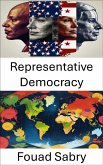Discover the dynamics of modern governance with Cabinet of Government, part of the Political Science series. This essential book delves into the core elements shaping executive power. It's a must-read for professionals, students, and those curious about political strategies and decision-making.
1: Cabinet (Government) - Learn about the cabinet's fundamental role as the backbone of the executive branch in various political systems.
2: Head of Government - Explore the global variations in the role of the head of government and its impact on policy.
3: Prime Minister - Examine the prime minister's powers and responsibilities within parliamentary systems.
4: Parliamentary System - Understand how parliamentary systems organize executive and legislative branches for cohesive governance.
5: Minister (Government) - Discover the diverse roles of ministers and their collective responsibilities within the cabinet.
6: Cabinet Collective Responsibility - Investigate the principle of collective responsibility and its effect on government accountability.
7: Ministers in New Zealand - Learn about New Zealand's unique cabinet system and ministerial roles.
8: Fusion of Powers - Examine how executive and legislative functions are blended in certain political systems.
9: Government of Barbados - Understand the cabinet's role in Barbados' political structure.
10: Government of Malaysia - Analyze the composition and impact of Malaysia's cabinet on governance.
11: Head of State - Differentiate between the roles of head of state and head of government.
12: Politics of Mongolia - Learn about Mongolia's political structure and its cabinet's role.
13: Westminster System - Understand the Westminster system's evolution and global influence.
14: Presidency - Explore the presidency's role in shaping executive power in various political systems.
15: Presidential System - Compare presidential systems with other forms of government.
16: List of Countries by System of Government - View a comprehensive list of global government systems.
17: Parliament of Malaysia - Understand Malaysia's parliamentary system and its interaction with the cabinet.
18: Cabinet of Australia - Analyze Australia's cabinet and its role in the political system.
19: Indirect Election - Learn about indirect election processes and their effects on governance.
20: Australian Government - Explore the executive and legislative branches of the Australian government.
21: New Zealand Government - Review New Zealand's cabinet system and its role within its government.
Cabinet of Government offers an in-depth exploration of executive power, providing valuable insights into political cabinets worldwide. This book expands your understanding of governance and executive mechanisms on a global scale.
1: Cabinet (Government) - Learn about the cabinet's fundamental role as the backbone of the executive branch in various political systems.
2: Head of Government - Explore the global variations in the role of the head of government and its impact on policy.
3: Prime Minister - Examine the prime minister's powers and responsibilities within parliamentary systems.
4: Parliamentary System - Understand how parliamentary systems organize executive and legislative branches for cohesive governance.
5: Minister (Government) - Discover the diverse roles of ministers and their collective responsibilities within the cabinet.
6: Cabinet Collective Responsibility - Investigate the principle of collective responsibility and its effect on government accountability.
7: Ministers in New Zealand - Learn about New Zealand's unique cabinet system and ministerial roles.
8: Fusion of Powers - Examine how executive and legislative functions are blended in certain political systems.
9: Government of Barbados - Understand the cabinet's role in Barbados' political structure.
10: Government of Malaysia - Analyze the composition and impact of Malaysia's cabinet on governance.
11: Head of State - Differentiate between the roles of head of state and head of government.
12: Politics of Mongolia - Learn about Mongolia's political structure and its cabinet's role.
13: Westminster System - Understand the Westminster system's evolution and global influence.
14: Presidency - Explore the presidency's role in shaping executive power in various political systems.
15: Presidential System - Compare presidential systems with other forms of government.
16: List of Countries by System of Government - View a comprehensive list of global government systems.
17: Parliament of Malaysia - Understand Malaysia's parliamentary system and its interaction with the cabinet.
18: Cabinet of Australia - Analyze Australia's cabinet and its role in the political system.
19: Indirect Election - Learn about indirect election processes and their effects on governance.
20: Australian Government - Explore the executive and legislative branches of the Australian government.
21: New Zealand Government - Review New Zealand's cabinet system and its role within its government.
Cabinet of Government offers an in-depth exploration of executive power, providing valuable insights into political cabinets worldwide. This book expands your understanding of governance and executive mechanisms on a global scale.
Dieser Download kann aus rechtlichen Gründen nur mit Rechnungsadresse in A, B, BG, CY, CZ, D, DK, EW, E, FIN, F, GR, H, IRL, I, LT, L, LR, M, NL, PL, P, R, S, SLO, SK ausgeliefert werden.









